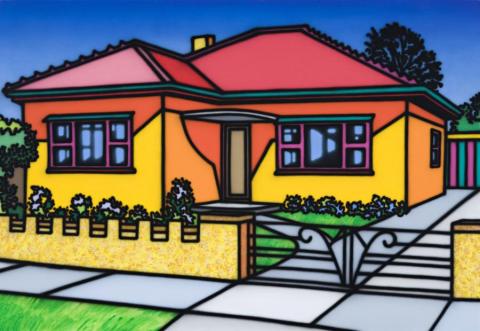A SPLENDID SUPERIOR HOME, 1989
HOWARD ARKLEY
synthetic polymer paint on canvas
174.5 x 254.0 cm
signed, dated and inscribed with title verso: Howard Arkley 89/ HOWARD ARKLEY/ "A SPLENDID SUPERIOR HOME"/ 1989
Tolarno Galleries, Melbourne
Private collection, Melbourne
The following extract is quoted from Crawford, A. and Ray, E., Spray: The Work of Howard Arkley, Craftsman House, Sydney, 1995, pp.88-89:
...Arkley's homes are far from ironic - they appear as if painted by a proud owner. Yet, ironically, given Arkley's engagement with feminism, it was the suburbs that feminists often accused of locking women into the subordinate role of home-maker. The movement which had motivated his earlier work could be seen in his celebration of the house, regarded throughout the modern era as a woman's domain, far from the masculine world of work. Yet one could also contend that his emphasis on the suburban exterior reasserted a masculine image of the home for it was often a male responsibility to maintain the suburban façade, with its driveway, ornamental garden beds and neatly mown.
Regardless of these issues, the Australian dream is to own one's own home, and here the ambition was writ large and loud as Arkley took the house as a commodity and rendered it as a marketable façade with a Pop aesthetic. This was a Pop sensibility attuned to the Antipodes and pulsing with knowing and self-awareness. Arkley knew his audience would recognise the message and identify with the dream of the house. His confidence was reflected in the stridency of the airbrushed panels, throbbing and resonating with a keen sense of an Australian aesthetic. When Arkley first showed his vibrant interpretations of this symbol, it was as if the penny had dropped not only for the artist but for the public. Pop had come to the Australian suburbs and the suburbs had come to Pop:
'What I am trying to do, I believe, is explicitly the right thing, and if it isn't me, it will be someone else. It has to be done. And we're not just talking about the work, but inspiring a whole generation of future artists to delve into this area and exploit it. It looks like an overstatement, like it's obvious, and I would rather make subtler art, but I don't think it will get across.
What I would actually like to do is equivalent to when you're driving along in the country and you look at the landscape and you say 'Oh, there's a Fred Williams.' You change the way people see it. And you can make people look at it. In the same way that David Hockney has changed the way people can look at Los Angeles, the swimming pools, Hollywood's Mulholland Drive, good God, that could be Lower Templestowe Road! I just want people to see it.'
